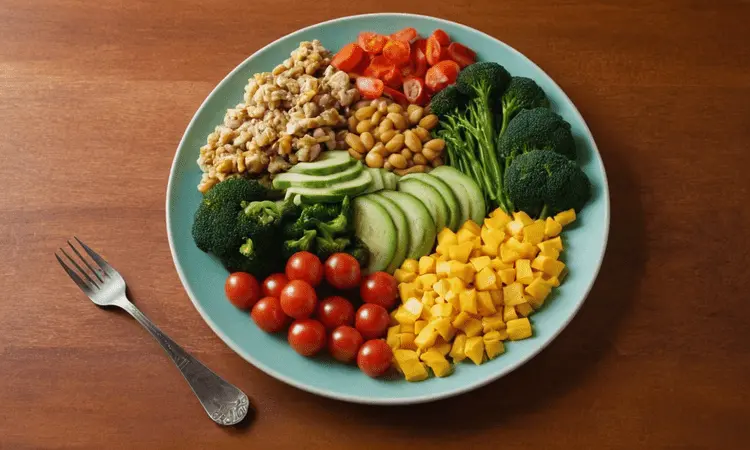Diabetic diet guidelines can be downright confusing. What can you eat? Are your favorite dishes off-limits? Navigating meal planning with diabetes can feel overwhelming.
Conflicting information about diabetic-friendly foods leaves you confused and frustrated. Restrictive diets feel unsustainable, and you worry about managing your blood sugar effectively.
The right diabetic diet guidelines empower you to create a delicious and satisfying eating plan that supports your health.
This comprehensive guide will break down diabetes and nutrition, giving you the tools to make informed choices and enjoy a balanced, blood sugar friendly diet.
Diabetic Diet Guidelines: The Essentials
- Eat plenty of vegetables
- Choose lean proteins
- Prioritize healthy fats
- Control carbohydrate portions
- Seek support when needed
Table of contents
Introduction

Diabetic Diet Guidelines –Understanding Diabetes and Your Diet
Feeling overwhelmed about what to eat with diabetes? You’re not alone! Let’s break down what diabetes is and why your food choices matter so much.
- What is diabetes? It’s when your body has trouble keeping blood sugar levels in a healthy range. Food plays a huge role in managing those levels!
- Think of it this way: The food you eat turns into sugar (glucose) in your bloodstream. To use that sugar, your body needs insulin. With diabetes, either your body doesn’t make enough insulin or doesn’t use it well.
The Core Principles of a Diabetic-Friendly Diet
So, what does a “diabetic-friendly diet” actually mean? It’s about making smart choices, not endless restrictions. Here’s the foundation:
- Focus on whole foods: Think fresh fruits, veggies, lean proteins, and whole grains.
- Watch those portions: Even healthy foods need to be eaten in the right amounts.
- Get familiar with the glycemic index (GI): This tool shows you how much a food might spike your blood sugar. Need a crash course on GI? Check out this guide from the American Diabetes Association.
- Find healthy fats and lean proteins: These help you feel full and keep blood sugar stable.
Let’s dive deeper into each of these core principles – knowledge is power! Got a question? Drop it in the comments, or tag me on social media!
Think you know everything about eating with diabetes? These insider tips might just surprise you and make managing your blood sugar even easier.
Key Food Groups and Building Blocks
Mastering Carbohydrate Choice and Control
Carbohydrates…the friend or foe in a diabetic diet? The truth is, they can be both! The key is choosing the right carbs wisely, at the right times. Let’s break it down:
- Think Like a Tortoise, Not a Hare: Low-glycemic index (GI) carbs are your friends. These release sugar slowly into your bloodstream, avoiding blood sugar spikes. Focus on fruits, vegetables, whole grains, and legumes.
- Need a Measuring Cup? Whether counting carbs or using the plate method, understanding portion sizes is key for your diabetic diet guidelines.
Diabetic Diet Guidelines – The Power of Protein
Protein, your blood sugar stabilizer! Think of it as a steady fuel source. Where’s the best protein?
- Get Lean: Opt for lean options like chicken, fish, beans, tofu, and low-fat dairy.
Don’t Fear Fats: Choosing the Right Ones
Worried about fats with diabetes? Ditch the fear, and focus on the right kind. Unsaturated fats are your superstars.
- Embrace Healthy Fats: Olive oil, nuts, seeds, and avocados should be in your diet. Check out these resources from the American Heart Association on [Healthy Fats for People with Diabetes](insert link).
- Limit the “Bad” Fats: Saturated and trans fats aren’t your friends. Minimize those as much as possible.
Vegetables: The Cornerstone of Your Diet
Veggies – a diabetic diet’s best friend! Pile ’em high, especially the non-starchy type. Think greens, broccoli, you name it! How can you get them into every meal?
- Bulk Up Meals: Add them to omelets, stir-fries, or soups.
- Sensational Salads: The base of a quick, healthy lunch.
- Sneaky Snacks: Raw veggies with a touch of hummus – delicious!
Let’s Chat! Tell me – what’s your favorite way to get those veggies in? Share below, or tag me on social media!
Practical Applications and Considerations

Meal Planning Made Easy
Ready to put these diabetic diet guidelines into action? Let’s make meal planning a breeze! Here’s what a day on your plate might look like:
- Breakfast: Oatmeal with berries and nuts, or a veggie omelet
- Lunch: Big salad with grilled chicken or fish, whole-grain wrap
- Dinner: Salmon with roasted vegetables, or lentil soup with a whole-wheat roll
- Snacks: Fruit, yogurt, handful of mixed nuts
Additionally, dining out doesn’t have to derail your healthy eating. Is there a way to customize menu items? Opt for grilled or baked dishes, ask for sauces on the side, and prioritize veggies and lean protein choices.
Beyond the Basics: Special Considerations
Everyone’s needs are different! Let’s talk about tailoring your diabetic diet guidelines to fit your life:
- Activity Levels: If you’re highly active, you may need to adjust your carb intake around exercise.
- Food Allergies/Intolerances: No worries! There are plenty of delicious substitutes for common allergens – a registered dietician can help navigate these.
- Cultural Preferences: Your favorite dishes can absolutely have a place in a diabetic-friendly diet – think about portion sizes and healthy ingredient swaps.
Remember, consistency is key! Even small changes every day lead to big benefits for your blood sugar and overall health.
Combating Challenges and Staying Motivated
Sticking to a diabetic diet guideline can be tough. Let’s be honest – cravings pop up, life gets busy, and sometimes you just want a break. But is giving in worth throwing your health goals out the window?
Here’s the deal: Managing diabetes is a marathon, not a sprint. So, let’s ditch demotivation and focus on strategies to stay in control.
Overcoming Obstacles
- Challenge: Cravings that try to derail you
- Solution: Plan ahead! Have healthy snacks within reach, outsmart cravings with a quick walk, or indulge in a flavorful sugar-free treat.
- Challenge: Emotional eating
- Solution: Recognize your triggers. Are you stressed? Bored? Identify the feeling behind the urge to eat and address it head-on. Seek healthier outlets for managing emotions.
- Challenge Busy lifestyle
- Solution: Prep is your best friend! Batch cook meals, use your slow cooker, and stock your pantry with healthy staples. Learn how to make smart choices when eating out by utilizing resources like the American Heart Association’s recommendations for healthy fats for people with diabetes [invalid URL removed].
Finding Support and Inspiration
Staying motivated is easier when you’re not alone. Build a strong support system – friends, family, online communities, even a registered dietitian! Their encouragement can make a world of difference.
Blood Sugar Monitoring & Your Diet
Understanding the Relationship
Think of your blood sugar levels as a dynamic dance partner. What you eat directly impacts their moves! Understanding this connection is key to managing your diabetes through a smart diabetic diet.
A blood glucose meter is your dance instructor. It shows you how your meals and snacks are affecting those blood sugar levels. Is monitoring worth the effort? Absolutely! This knowledge gives you power.
Adjusting Your Diet Based on Blood Sugar Readings
Each blood sugar reading offers clues. Were your numbers a bit high after that pasta dinner? Maybe dial back the portion next time or add a side salad! Did a morning walk give you a fantastic reading? That’s a win to repeat!
With a little practice, you’ll start deciphering those blood glucose results. It’s like learning a new dance – be patient with yourself. A registered dietitian or diabetes educator can help you master those steps
Here’s a quick guide:
- High blood sugar: Could mean your portion sizes need tweaking, or the types of carbs in your meal need adjustments for better control.
- Low blood sugar: You may need a snack before activity or might need to adjust medication levels (always consult your doctor regarding medication).
Supplements and Special Diets

The Role of Supplements
Supplements can be tempting. They promise quick fixes and easy solutions for managing diabetes. But do they really work? Is there a magic pill that can replace healthy eating habits?
The truth is, most supplements lack solid scientific backing. While some, like chromium or cinnamon, might have small, potential benefits for blood sugar control, it’s crucial to talk to your doctor first.
Supplements can interact with your diabetes medications or have unexpected side effects.
Exploring Specialized Diets
Have you heard the buzz about low-carb diets or the Mediterranean diet for managing diabetes? These specialized approaches might pique your interest, but are they right for you?
- Low-Carb Diets: These focus on drastically reducing carbohydrate intake. While they may lead to short-term blood sugar improvements, they can be difficult to stick with and may lack essential nutrients in the long run.
- Mediterranean Diet: This emphasizes fruits, vegetables, whole grains, healthy fats, and lean protein – a pattern that naturally aligns with diabetic diet guidelines. Want to learn more about the Mediterranean approach? Check out this detailed guide on how it can benefit people with diabetes.
Ultimately, the best diet is the one you can sustain. Before drastically switching your eating pattern, consult a registered dietitian or diabetes educator. They can help you determine if a specialized diet is safe and appropriate for your individual needs.
Let’s Chat Have you tried any supplements or special diets for managing your diabetes? Share your experiences in the comments below!
Don’t just manage diabetes, thrive with it! Learn how the Blood Sugar Control Diet can minimize spikes, crashes, and give you more energy than ever.
FAQs: Your Diabetic Diet Questions Answered
Focus on whole foods, balanced meals, healthy fats, lean protein, and lots of non-starchy vegetables. Control portions and be mindful of carbohydrates.
A diabetic-friendly diet emphasizes fresh produce, whole grains, lean protein, and healthy fats. It limits processed foods, sugary drinks, and unhealthy fats.
There’s no need to completely “avoid” foods, but limiting these is wise: sugary drinks, refined carbs (white bread, pastries), processed snacks, and foods high in saturated and trans fats.
There’s no single “best” food, but these superstars should be staples: non-starchy vegetables, lean protein, healthy fats (nuts, seeds, avocado), and fiber-rich whole grains.
Yes! Moderation and smart swaps let you indulge occasionally.
Focus on serving size, total carbohydrates (especially sugar and fiber), and ingredients.
Consistency is more important than strict timing. Eat regularly to avoid blood sugar swings.
Alcohol can impact blood sugar. Drink in moderation, with food, and monitor your levels.
They offer sweetness without the sugar spike, but use them sparingly. Whole foods are always best.